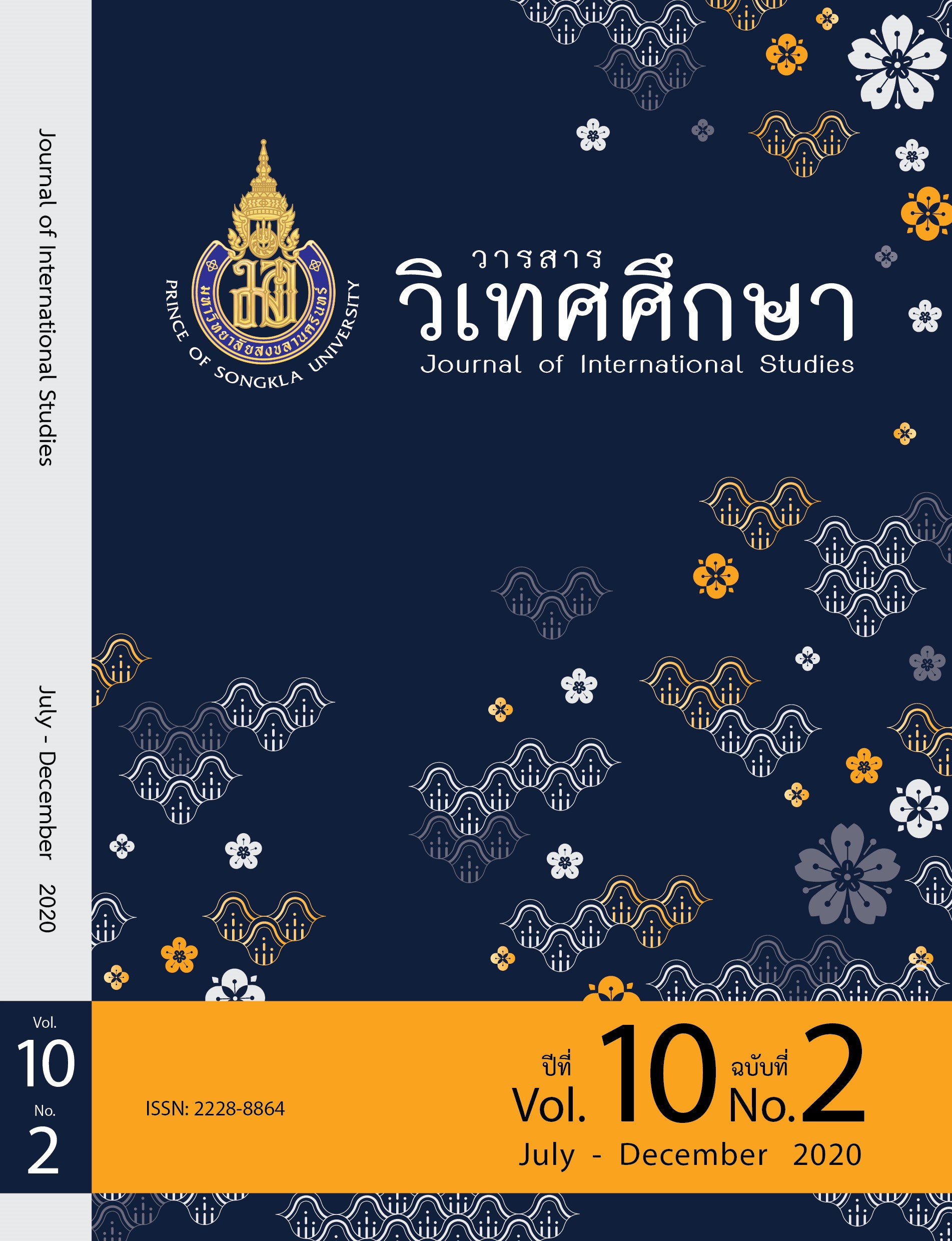Motivation influencing consumers’ behavior of local street food in Phuket
Main Article Content
Abstract
This study aimed to investigate the effect between motivation to satisfaction and customer loyalty. Moreover, to analyze satisfaction mediated the effect between motivation to customer loyalty. This study collected from 384 Thai tourists in Phuket with questionnaires. The data was analyzed structural equation modeling. The results showed that 1) Personal requirement, sensory attributes, and food varieties directly affected to satisfaction. 2) Food varieties and price directly influenced customer loyalty. 3) Satisfaction as a mediator found that satisfaction mediated the influence personal requirement, sensory attributes, and food varieties to customer loyalty.
Article Details
Statements and opinions expressed in articles herein are those of the authors and do not necessarily reflect the position of the editors or publisher.
Article, information, text, image, etc. which are published in Journal of International Studies, belong to Journal of International Studies. If anybody or any organization would like to use part or whole of them, they must receive written permission from Journal of International Studies before usage.
References
การท่องเที่ยวแห่งประเทศไทย. (2560). Go local. สืบค้นเมื่อ 17 พฤษภาคม 2561, จาก
https://thai.tourismthailand.org/
การท่องเที่ยวแห่งประเทศไทย. (2560). Food Tourism 2.0.สืบค้นเมื่อ 17 พฤษภาคม 2561, จาก
http://etatjournal.com/web/menu-read-tat/menu-2017/92-cate-2017-jan-mar/757-12017-food-tourism2.
ชัยนันต์ ไชยเสน. (2562). แนวทางการเพิ่มขีดความสามารถและนวัตกรรมการบริการธุรกิจร้านอาหารยุค 4.0 เพื่อส่งเสริมและพัฒนาจังหวัดภูเก็ตเป็นเมืองสร้างสรรค์ด้านอาหาร. วารสารวิทยาลัยดุสิตธานี, 13(3), 491- 504.
ณัฐริดา มงคลคีรี และเจริญชัย เอกมาไพศาล. (2561) การศึกษาปัจจัยผลักดันและดึงดูดที่มีอิทธิพลต่อพฤติกรรมการบริโภค อาหารริมทางของนักท่องเที่ยวไทย กรณีศึกษา ตลาดโต้รุ่งหัวหิน จังหวัดประจวบคีรีขันธ์. BU Academic Review, 17(1), 18-32.
ธนวัต คองประเสริฐ, สมชนก ภาสกรจรัส, และ พันธุมดี เกตะวันดี. (2557). ปัจจัยที่มีอิทธิพลต่อประเภทนักท่องเที่ยวญี่ปุ่นในจังหวัดเชียงใหม่. วารสารวิทยาการจัดการ, 31(2), 1-33.
นิมิต ซุ้นสั้น. (2562). การวิเคราะห์แรงจูงใจของนักท่องเที่ยวชาวไทยที่เดินทางมาถนนวัฒนธรรม: กรณีศึกษาถนนวัฒนธรรมหลาดใหญ่ จังหวัดภูเก็ต. วารสารวิชาการมหาวิทยาลัยหอการค้าไทย (มนุษยศาสตร์และสังคมศาสตร์), 39(2), 16-31.
พิชญา แสงธูป และเจริญชัย เอกมาไพศาล. (2561). การศึกษาปัจจัยผลักดันและปัจจัยดึงดูดที่มีอิทธิพลต่อการบริโภคอาหารริมทางของผู้บริโภคชาวไทย: กรณีศึกษา ร้านอาหารริมทาง ย่านถนนเยาวราช กรุงเทพมหานคร. จุฬาลงกรณ์ธุรกิจปริทัศน์, 40(156), 103-145.
พิมพ์ระวี โรจน์รุ่งสัตย์. (2561). การพัฒนารูปแบบการจัดการภาพลักษณ์อาหารท้องถิ่นเพื่อเสริมสร้างความจงรักภักดีของนักท่องเที่ยวในจังหวัดเพชรบุรี. วารสารวิชาการการท่องเที่ยวไทยนานาชาติ, 14(1), 152-167.
โอปอล์ สุวรรณเมฆ และอภิวรรตน์ กรมเมือง. (2562). ปัจจัยที่มีผลต่อความพึงพอใจในการบริโภคอาหารริมบาทวิถีในเขตกรุงเทพมหานคร. วารสารบริหารธุรกิจศรีนครินทรวิโรฒ, 10(2), 144-155.
Bagozzi, R. P., & Yi, Y. (1988). On the evaluation of structural equation models. Journal of the Academy of Marketing Science, 16(1), 74-94.
Caber, M., & Albayrak, T. (2016). Push or pull? Identifying rock climbing tourists’ motivations. Tourism Management, 55, 74-84.
Chang, R. C. Y., Kivela, J., & Mak, A. H. N. (2011). Attributes that influence the evaluation of travel dining experience: When East meets West. Tourism Management, 32(2), 307–316.
Crompton, J. L. (1979). Motivations for pleasure vacation. Annals of Tourism Research, 6(4), 408-424.
Dann, G. M. (1977). Anomie, ego-enhancement and tourism. Annals of Tourism Research, 4(4), 184-194.
Dimitrovski, D., & Crespi-Vallbona, M. (2017). Role of food neophilia in food market tourists’ motivational construct: The case of La Boqueria in Barcelona, Spain. Journal of Travel & Tourism Marketing, 34(4), 475–487
Evanschitzky, H., Ramaseshan, B., Woisetschläger, D. M., Richelsen, V., Blut, M., & Backhaus, C. (2012). Consequences of customer loyalty to the loyalty program and to the company. Journal of the Academy of Marketing Science, 40(5), 625-638.
Fornell, C., & Larcker, D. F. (1981). Eveluating structural equation models with unobservable variables and measure. Journal of marketing research, 18, 39-50.
Goeldner, C. R. & Ritchie, J. R. (2012). Tourism: Principles, practices, philosophies (12th ed.). Toronto: Wiley.
Hair, J. F., Anderson, B. W., Babin, B. J., & Anderson, R. E. (2010). Multivariate data analysis with reading (Vol. 4th). New Jersey: Prentice-Hall.
Hulland, J. (1999). Use of partial least squares (PLS) in strategic management research: A review of four recent studies. Strategic Management Journal, 20(2), 195-204.
Jeaheng, Y., Al-Ansi, A., & Han, H. (2020). Impacts of Halal-friendly services, facilities, and food and Beverages on Muslim travelers’ perceptions of service quality attributes, perceived price, satisfaction, trust, and loyalty. Journal of Hospitality Marketing & Management, 1-25.
Kandampully, J., Zhang, T. C., & Bilgihan, A. (2015). Customer loyalty: a review and future directions with a special focus on the hospitality industry. International Journal of Contemporary Hospitality Management.
Kim, Y. G., Eves, A., & Scarles, C. (2013). Empirical verification of a conceptual model of local food consumption at a tourist destination. International Journal of Hospitality Management, 33(1), 484–489.
Khongtong, J., Ab Karim, S., Othman, M., & Bolong, J. (2014). Consumption pattern and consumers' opinion toward street food in Nakhon Si Thammarat province, Thailand. International Food Research Journal, 21(1), 125-130.
Lin, C. H. (2014). Effects of cuisine experience, psychological well-being, and self-health perception on the revisit intention of hot springs tourists. Journal of Hospitality & Tourism Research, 38(2), 243-265.
Mak, A. H. N., Lumbers, M., Eves, A., & Chang, R. C. Y. (2012). Factors influencing tourist food consumption. International Journal of Hospitality Management, 31(3), 928–936.
Moutinho, L. (Ed.). (2000). Strategic management in tourism, New York, NY: CABI Publishing.
Nunnally, J. C. (1978). Psychomtietrictheory (Vol. 2nd). New York: McGraw-Hill.
Park, S. H., Lee, C. K., & Miller, J. C. (2015). A comparative study of the motivations, activities, overall satisfaction, and post-trip behaviors of international tourists in Macau: Mainland Chinese, Hongkongese, Taiwanese, and Westerners. Asia Pacific Journal of Tourism Research, 20(10), 1174-1193.
Prayag, G., Hassibi, S., & Nunkoo, R. (2019). A systematic review of consumer satisfaction studies in hospitality journals: conceptual development, research approaches and future prospects. Journal of Hospitality Marketing & Management, 28(1), 51-80.
So, K. K. F., King, C., Sparks, B. A. & Wang, Y. (2013). The influence of customer brand identification on hotel brand evaluation and loyalty. International Journal of Hospitality Management, 34, 31-41.
Tenenhaus, M., Vinzi, V. E., Chatelin, Y.-M., & Lauro, C. (2005). PLS path modeling. Computational Statistics & Data Analysis, 48(1), 159-205.
Tolman, E.C. (1959). Principles of purposive behavior. In S. Koch, Psychology: A study of a science: Vol. 2 (pp. 92-157). New York: McGraw-Hill.
Yeoman, I., & McMahon-Beatte, U. (2016). The future of food tourism. Journal of Tourism Futures, 2(1), 95-98.


